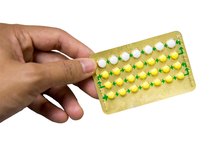What does fact checked mean?
At Healthfully, we strive to deliver objective content that is accurate and up-to-date. Our team periodically reviews articles in order to ensure content quality. The sources cited below consist of evidence from peer-reviewed journals, prominent medical organizations, academic associations, and government data.
- National Library of Medicine: Polycystic Ovary Syndrome
- Mayo Clinic: Congenital Adrenal Hyperplasia
- National Institutes of Health: Cushing's syndrome
- Mayo Clinic: Hirsutism Causes
- Mayo Clinic: PCOS
The information contained on this site is for informational purposes only, and should not be used as a substitute for the advice of a professional health care provider. Please check with the appropriate physician regarding health questions and concerns. Although we strive to deliver accurate and up-to-date information, no guarantee to that effect is made.
Facial Hair & Acne in Women in Their 30s
Many women continue to experience acne well beyond adolescence, and hormone fluctuations likely cause these breakouts. But women in their 30s who experience acne combined with facial hair growth might actually be suffering from polycystic ovary syndrome (PCOS), Cushing's syndrome or adrenal hyperplasia, according to the Mayo Clinic 13. Women in their 30s with acne and facial hair growth should consider being screened by their physician for these more serious health conditions, which are treatable.
Significance
Acne is caused in part by surging hormones known as androgens. This group of hormones, including testosterone, stimulates the glands in the skin that produce sebum, or skin oil. If your body has too many androgens, those hormones will over-stimulate your sebum-producing glands. The excess oil likely will clog your pores, causing acne.
- Acne is caused in part by surging hormones known as androgens.
- If your body has too many androgens, those hormones will over-stimulate your sebum-producing glands.
Function
What Causes Lip Hair Growth?
Learn More
Meanwhile, those same androgen hormones can cause your body to grow male-pattern facial hair, usually on your chin but also on your cheeks and above your mouth. Some women -- notably those whose ancestors came from Europe -- grow hair on their faces due to their genetics. But in other women, excess androgens are to blame, according to the Mayo Clinic 3.
Types
Women in their 30s who have facial hair and acne may suffer from PCOS, which is a disease that affects hormone levels. PCOS generally is diagnosed in your 20s or 30s, and can cause:
- irregular or absent menstrual periods
- decreased breast size
- infertility
- weight gain
- diabetes
Facial hair and acne also may point to congenital adrenal hyperplasia, where the body makes too little cortisol hormone and too many androgens, according to the Mayo Clinic 3. Women in their 30s who have facial hair and acne may also have Cushing's syndrome, in which their body makes too much cortisol, according to the National Institute of Diabetes and Digestive and Kidney Diseases.
Identification
Herbal Treatment for Excessive Facial Hair on Women
Learn More
To determine the cause of acne and facial hair growth, a woman in her 30s would need a complete checkup from a physician, the Mayo Clinic says 3. That examination likely would include a complete medical history, plus blood tests to determine if the body's androgen levels are elevated. In addition, clinicians might use ultrasound or a computerized tomography (CT) scan to evaluate the adrenal glands, which produce cortisol. If PCOS is suspected, the physician likely would perform a pelvic examination.
Considerations
Treatment for facial hair and acne will depend on the root cause. If your physician diagnoses you with PCOS, several medications, including oral contraceptives, can help treat the symptoms. If you have congenital adrenal hyperplasia, your physician may prescribe steroids, and if you have Cushing's syndrome, treatment can include surgery or cortisol-inhibiting prescription drugs. And even if your physician ultimately finds no root cause for your acne and facial hair, she still can prescribe medications to curb the pimples and excess hair.
- Treatment for facial hair and acne will depend on the root cause.
- If your physician diagnoses you with PCOS, several medications, including oral contraceptives, can help treat the symptoms.
Related Articles
References
- National Library of Medicine: Polycystic Ovary Syndrome
- Mayo Clinic: Hirsutism Causes
- Mayo Clinic: PCOS
- Bani Mohammad M, Majdi Seghinsara A. Polycystic Ovary Syndrome (PCOS), Diagnostic Criteria, and AMH. Asian Pac J Cancer Prev. 2017;18(1):17–21. Published 2017 Jan 1. doi:10.22034/APJCP.2017.18.1.17
- Antoniou-Tsigkos A, Zapanti E, Ghizzoni L, et al. Adrenal androgens. Endotext. Updated January 5, 2019.
- Horstman AM, Dillon EL, Urban RJ, Sheffield-Moore M. The role of androgens and estrogens on healthy aging and longevity. J Gerontol A Biol Sci Med Sci. 2012;67(11):1140–1152. doi:10.1093/gerona/gls068
- Pasquali R, Zanotti L, Fanelli F, et al. Defining Hyperandrogenism in Women With Polycystic Ovary Syndrome: A Challenging Perspective. J Clin Endocrinol Metab. 2016;101(5):2013-22.
- Rosenfield RL, Ehrmann DA. The Pathogenesis of Polycystic Ovary Syndrome (PCOS): The Hypothesis of PCOS as Functional Ovarian Hyperandrogenism Revisited. Endocr Rev. 2016;37(5):467–520. doi:10.1210/er.2015-1104
- Rosenfield RL. The Polycystic Ovary Morphology-Polycystic Ovary Syndrome Spectrum. J Pediatr Adolesc Gynecol. 2015;28(6):412–419. doi:10.1016/j.jpag.2014.07.016
- Yildiz BO, Bolour S, Woods K, Moore A, Azziz R. Visually scoring hirsutism. Hum Reprod Update. 2010;16(1):51–64. doi:10.1093/humupd/dmp024
- Held BL, Nader S, Rodriguez-rigau LJ, Smith KD, Steinberger E. Acne and hyperandrogenism. J Am Acad Dermatol. 1984;10(2 Pt 1):223-6.
- Shum KW, Cullen DR, Messenger AG. Hair loss in women with hyperandrogenism: four cases responding to finasteride. J Am Acad Dermatol. 2002;47(5):733-9.
- Yildiz BO. Diagnosis of hyperandrogenism: clinical criteria. Best Pract Res Clin Endocrinol Metab. 2006;20(2):167-76.
- Stanczyk FZ. Diagnosis of hyperandrogenism: biochemical criteria. Best Pract Res Clin Endocrinol Metab. 2006;20(2):177-91.
- Azziz R, Carmina E, Dewailly D, et al. The Androgen Excess and PCOS Society criteria for the polycystic ovary syndrome: the complete task force report. Fertil Steril. 2009;91(2):456-88.
- Wang R, Mol BW. The Rotterdam criteria for polycystic ovary syndrome: evidence-based criteria?. Hum Reprod. 2017;32(2):261-264.
- McCartney CR, Marshall JC. CLINICAL PRACTICE. Polycystic Ovary Syndrome. N Engl J Med. 2016;375(1):54–64. doi:10.1056/NEJMcp1514916
- Sheehan MT. Polycystic ovarian syndrome: diagnosis and management. Clin Med Res. 2004;2(1):13–27. doi:10.3121/cmr.2.1.13
- New M, Yau M, Lekarev O, et al. Congenital Adrenal Hyperplasia. [Updated 2017 Mar 15]. In: Feingold KR, Anawalt B, Boyce A, et al., editors. Endotext [Internet]. South Dartmouth (MA): MDText.com, Inc.; 2000-.
- Kairys N, Schwell A. Cushing Disease. [Updated 2019 May 5]. In: StatPearls [Internet]. Treasure Island (FL): StatPearls Publishing; 2019 Jan-.
- Allen MJ, Sharma S. Physiology, Adrenocorticotropic Hormone (ACTH) [Updated 2019 Mar 3]. In: StatPearls [Internet]. Treasure Island (FL): StatPearls Publishing; 2019 Jan-.
- Blouin K, Boivin A, Tchernof A. Androgens and body fat distribution. J Steroid Biochem Mol Biol. 2008;108(3-5):272-80.
- Sam S. Obesity and Polycystic Ovary Syndrome. Obes Manag. 2007;3(2):69–73. doi:10.1089/obe.2007.0019
- Diamanti-Kandarakis E, Dunaif A. Insulin resistance and the polycystic ovary syndrome revisited: an update on mechanisms and implications. Endocr Rev. 2012;33(6):981–1030. doi:10.1210/er.2011-1034
- Corbould A. Effects of androgens on insulin action in women: is androgen excess a component of female metabolic syndrome?. Diabetes Metab Res Rev. 2008;24(7):520-32.
- Dokras A. Cardiovascular disease risk factors in polycystic ovary syndrome. Semin Reprod Med. 2008;26(1):39-44.
- Mueck AO. Treatment of hyperandrogenism in women with ethinylestradiol and cyproteroneacetate. Eur J Contracept Reprod Health Care. 2017;22(3):170-171.
- de Melo AS, Dos Reis RM, Ferriani RA, Vieira CS. Hormonal contraception in women with polycystic ovary syndrome: choices, challenges, and noncontraceptive benefits. Open Access J Contracept. 2017;8:13–23. Published 2017 Feb 2. doi:10.2147/OAJC.S85543
- Reismann P, Likó I, Igaz P, Patócs A, Rácz K. Pharmacological options for treatment of hyperandrogenic disorders. Mini Rev Med Chem. 2009;9(9):1113-26.
- Karakurt F, Sahin I, Güler S, et al. Comparison of the clinical efficacy of flutamide and spironolactone plus ethinyloestradiol/cyproterone acetate in the treatment of hirsutism: a randomised controlled study. Adv Ther. 2008;25(4):321-8.
- Kolodziejczyk B, Duleba AJ, Spaczynski RZ, Pawelczyk L. Metformin therapy decreases hyperandrogenism and hyperinsulinemia in women with polycystic ovary syndrome. Fertil Steril. 2000;73(6):1149-54.
- Sachdeva S. Hirsutism: evaluation and treatment. Indian J Dermatol. 2010;55(1):3–7. doi:10.4103/0019-5154.60342
- Chuan SS, Chang RJ. Polycystic ovary syndrome and acne. Skin Therapy Lett. 2010;15(10):1-4.
- Brady C, Mousa SS, Mousa SA. Polycystic ovary syndrome and its impact on women's quality of life: More than just an endocrine disorder. Drug Healthc Patient Saf. 2009;1:9–15. doi:10.2147/dhps.s4388
- Badawy A1, Elnashar A. “Treatment options for polycystic ovary syndrome.” Int J Womens Health. 2011 Feb 8;3:25-35. doi: 10.2147/IJWH.S11304.
- Alpañés, Macarena; Fernández-Durán, Elena; Escobar-Morreale, Héctor F. Androgens and Polycystic Ovary Syndrome.
- Armeni E1, Lambrinoudaki I2. “Androgens and cardiovascular disease in women and men.” Maturitas. 2017 Oct;104:54-72. doi: 10.1016/j.maturitas.2017.07.010. Epub 2017 Jul 29.
- Karrer-Voegeli S1, Rey F, Reymond MJ, Meuwly JY, Gaillard RC, Gomez F. “Androgen dependence of hirsutism, acne, and alopecia in women: retrospective analysis of 228 patients investigated for hyperandrogenism.” Medicine (Baltimore). 2009 Jan;88(1):32-45. doi: 10.1097/md.0b013e3181946a2c.
- Simon, James. Androgen. HealthyWomen.org.
Writer Bio
J.M. Andrews has been a professional journalist for more than 20 years. She specializes in health and medical content for consumers and health professionals. Andrews' background in medicine and science has earned her credits in a wide range of online and print publications, including "Young Physicians" magazine.








